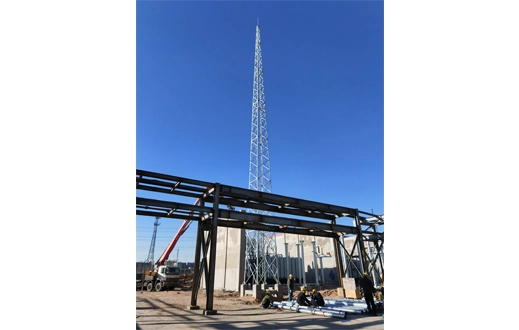Foundation excavation: Excavate the foundation as required, and then pour concrete.
Manufacturing and assembly: The pre-fabricated components are transported to the site for assembly, including the pole body, cross arm, hanging point and other parts.
After the assembly is completed, the power steel lattice pole is hoisted with lifting equipment and placed in the pre-laid foundation hole, and then the surrounding gap is filled with gravel, cement and other materials to fix the power steel pole on the foundation. Dynamic balance: For large power steel poles, dynamic balance tests are required.
Grounding: The power steel pole needs to be grounded to the ground to reduce the risk of fire and lightning strikes.
Wire installation: The transmission wire is fixed to the installed power steel pole and then connected to the power grid of the power station or substation.
1. Electrical Power Distribution
Support high-voltage transmission lines (up to 500 kV or more).
Distribute electricity in urban, industrial, and rural areas.
2. Telecommunications & Broadband Networks
Carry fiber optic cables, telephone lines, and internet cables.
Often used alongside electrical lines in shared utility corridors.
3. Street Lighting & Traffic Signals
Provide sturdy mounting points for LED streetlights, traffic lights, and cameras.
4. Railway & Metro Electrification
Support overhead catenary wires that power electric trains and trams.
5. Renewable Energy Projects (Wind & Solar Farms)
Used in solar panel support structures and wind farm electrical distribution.
✅ Higher Strength – Can carry heavier loads & higher voltages.
✅ Longer Lifespan (50+ years) – Resistant to rot, termites, and corrosion (if galvanized).
✅ Minimal Maintenance – Unlike wood, they don’t need frequent replacements.
✅ Fireproof – Critical in wildfire-prone areas.
✅ Eco-Friendly Option – 100% recyclable at end-of-life.
Electrical Steel Pole: Backbone of Modern Power Transmission
The Extraordinary Features of Electrical Steel Poles
